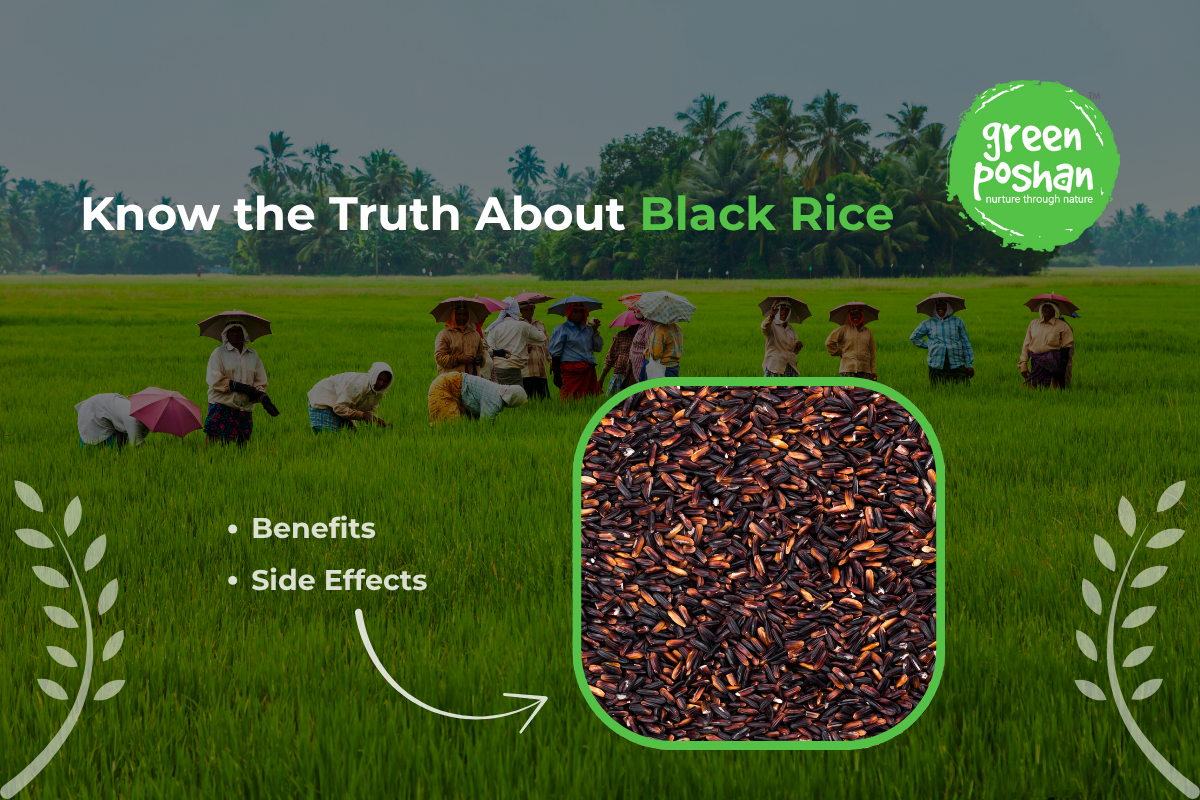Black rice has become a trending superfood in recent years, and not without reason. Once called “forbidden rice” and reserved for royalty in ancient China, this dark-hued grain is now gaining popularity across India. But does it live up to the hype? In this article, we’ll explore the black rice nutrition value, its glycemic index, key health benefits, and potential side effects. Whether you’re switching grains for better health or simply curious, this balanced guide will help you make an informed choice.
What Is Black Rice?
Black rice is a type of unpolished whole grain rice with a deep purple-black color, attributed to its high content of anthocyanins, powerful antioxidants also found in blueberries. Unlike white rice, black rice retains its bran and germ layers, making it more nutritious and fiber-rich.
Black Rice Nutrition Value: What’s Inside?
Here’s a snapshot of the average nutritional value per 100 grams of cooked black rice:
| Nutrient | Amount |
| Calories | 150 kcal |
| Protein | 4.5 g |
| Fiber | 3.0 g |
| Iron | 1.8 mg |
| Carbohydrates | 34 g |
| Fat | 1.5 g |
| Anthocyanins | High |
Its combination of fiber, iron, plant-based protein, and antioxidants makes black rice a great addition to a balanced diet.
Black Rice Glycemic Index: A Smart Carb Choice
The glycemic index (GI) of black rice is around 42 to 45, which is considered low. This means it causes a gradual rise in blood sugar levels — making it a healthier option for people managing diabetes or looking to maintain stable energy levels throughout the day.
Unlike high-GI foods like white rice or bread, black rice supports better appetite control and sustained energy, thanks to its slow digestion rate.
Black Rice — 500g
Black rice, often called the “forbidden rice,” is an ancient grain known for its striking dark colour, earthy flavour, and exceptional health benefits. Historically reserved for royalty in parts of Asia, black rice has earned its place in modern diets as a powerhouse of nutrients and antioxidants. With a rich, slightly nutty taste and a chewy texture, this rice is ideal for those looking to make their meals both nutritious and delicious.
Green Poshan brings you authentic 500g black rice, carefully sourced from trusted farms and packaged to retain freshness and quality. Also known as karuppu kavuni rice in South India, this variety is naturally rich in anthocyanins—the same antioxidants found in blueberries—which contribute to its deep black-purple colour and numerous health-supporting properties.
Key Health Benefits of Black Rice
1. Rich in Antioxidants
The deep color of black rice is a sign of its high anthocyanin content, which helps fight oxidative stress, supports heart and brain health, and may even reduce the risk of chronic diseases.
2. Promotes Digestive Health
With more fiber than most rice varieties, black rice aids digestion, prevents constipation, and helps detoxify the digestive system naturally.
3. Supports Weight Management
Its high fiber and protein content promote satiety, helping you feel full for longer and potentially reducing calorie intake throughout the day.
4. Good for Heart Health
Black rice may help reduce LDL cholesterol levels and inflammation, both of which are risk factors for cardiovascular issues.
5. Naturally Gluten-Free
Perfect for people with gluten intolerance or celiac disease, black rice is a safe and nutritious grain alternative.

Are There Any Side Effects of Black Rice?
While black rice is generally safe for most people, here are a few considerations:
- Digestive discomfort: People new to high-fiber grains may experience gas or bloating. Introduce gradually.
- Allergic reactions: Though rare, some may be allergic. Always monitor when trying a new grain.
- Portion control: It’s still a carbohydrate, so moderation is key in calorie-restricted diets.
Consult your nutritionist or physician if you have existing medical conditions before making dietary changes.
Black Rice in India: Tradition Meets Modern Health Goals
Black rice in India has been traditionally cultivated in the North-Eastern states like Manipur (where it’s known as Chakhao) and Assam. Today, it is also grown in Odisha, West Bengal, and Maharashtra. However, the growing demand has led to a wide variety of black rice being sold in the market — not all of them equally healthy.
Many locally sourced options may be grown using chemical fertilizers, pesticides, or polishing agents, which can significantly reduce the nutritional quality and introduce harmful residues.
Why Choose Green Poshan’s Black Rice?
Green Poshan offers a better choice. Our black rice is:
- Grown using traditional, chemical-free farming practices
- Free from synthetic additives and preservatives
- Sourced from trusted, local Indian farmers who value purity and sustainability
By choosing Green Poshan, you’re not only getting the full black rice nutrition value but also avoiding the hidden health risks of chemically treated or poorly stored rice. It’s a step toward cleaner eating and long-term wellness.
How to Add Black Rice Nutrition to Your Diet
Not sure how to cook with black rice? Here are some simple ways:
- Cook it as a base for a black rice salad
- Make a warm breakfast porridge with jaggery and coconut milk
- Use it in healthy Buddha bowls
- Try a traditional black rice kheer or pudding
Always remember to soak black rice for a few hours before cooking — it reduces cooking time and improves digestibility.
The Balanced Truth About Black Rice
Black rice is more than a trend — it’s a nutrient-dense, low-GI whole grain with real health benefits. From its antioxidant power to digestive support, it makes a strong case for being part of your everyday meals.
But quality matters. Avoid chemically treated or nutritionally stripped black rice available in the market. Choose trusted, clean options like Green Poshan, where purity and nutrition are always the priority.




